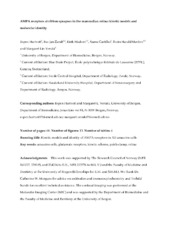AMPA receptors at ribbon synapses in the mammalian retina: kinetic models and molecular identity
Hartveit, Espen; Zandt, Bas-Jan; Madsen, Eirik; Castilho, Aurea; Mørkve, Svein Harald; Veruki, Margaret Lin
Peer reviewed, Journal article
Accepted version

View/
Date
2018Metadata
Show full item recordCollections
Original version
Brain Structure and Function. 2018, 223, 769–804. https://doi.org/10.1007/s00429-017-1520-1Abstract
In chemical synapses, neurotransmitter molecules released from presynaptic vesicles activate populations of postsynaptic receptors that vary in functional properties depending on their subunit composition. Differential expression and localization of specific receptor subunits are thought to play fundamental roles in signal processing, but our understanding of how that expression is adapted to the signal processing in individual synapses and microcircuits is limited. At ribbon synapses, glutamate release is independent of action potentials and characterized by a high and rapidly changing rate of release. Adequately translating such presynaptic signals into postsynaptic electrical signals poses a considerable challenge for the receptor channels in these synapses. Here, we investigated the functional properties of AMPA receptors of AII amacrine cells in rat retina that receive input at spatially segregated ribbon synapses from OFF-cone and rod bipolar cells. Using patch-clamp recording from outside-out patches, we measured the concentration dependence of response amplitude and steady-state desensitization, the single-channel conductance and the maximum open probability. The GluA4 subunit seems critical for the functional properties of AMPA receptors in AII amacrines and immunocytochemical labeling suggested that GluA4 is located at synapses made by both OFF-cone bipolar cells and rod bipolar cells. Finally, we used a series of experimental observables to develop kinetic models for AII amacrine AMPA receptors and subsequently used the models to explore the behavior of the receptors and responses generated by glutamate concentration profiles mimicking those occurring in synapses. These models will facilitate future in silico modeling of synaptic signaling and processing in AII amacrine cells.